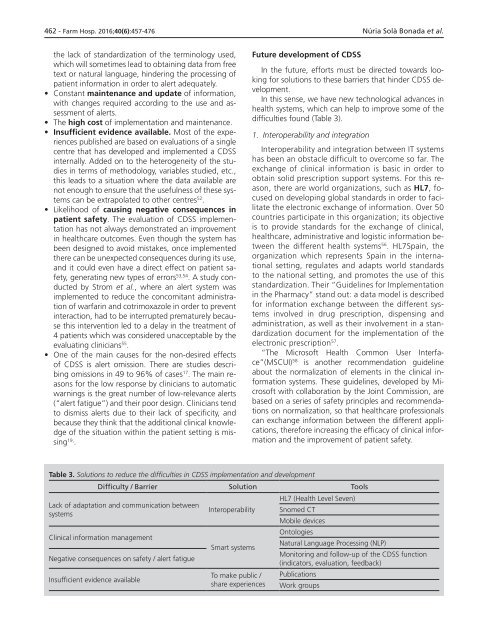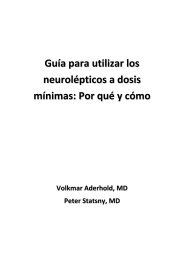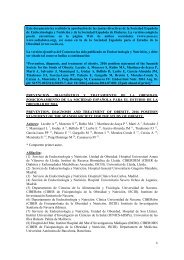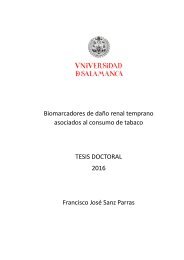Noviembre-Diciembre
156_v40n6(1)
156_v40n6(1)
Create successful ePaper yourself
Turn your PDF publications into a flip-book with our unique Google optimized e-Paper software.
462 - Farm Hosp. 2016;40(6):457-476 Núria Solà Bonada et al.<br />
the lack of standardization of the terminology used,<br />
which will sometimes lead to obtaining data from free<br />
text or natural language, hindering the processing of<br />
patient information in order to alert adequately.<br />
• Constant maintenance and update of information,<br />
with changes required according to the use and assessment<br />
of alerts.<br />
• The high cost of implementation and maintenance.<br />
• Insufficient evidence available. Most of the experiences<br />
published are based on evaluations of a single<br />
centre that has developed and implemented a CDSS<br />
internally. Added on to the heterogeneity of the studies<br />
in terms of methodology, variables studied, etc.,<br />
this leads to a situation where the data available are<br />
not enough to ensure that the usefulness of these systems<br />
can be extrapolated to other centres 52 .<br />
• Likelihood of causing negative consequences in<br />
patient safety. The evaluation of CDSS implementation<br />
has not always demonstrated an improvement<br />
in healthcare outcomes. Even though the system has<br />
been designed to avoid mistakes, once implemented<br />
there can be unexpected consequences during its use,<br />
and it could even have a direct effect on patient safety,<br />
generating new types of errors 53,54 . A study conducted<br />
by Strom et al., where an alert system was<br />
implemented to reduce the concomitant administration<br />
of warfarin and cotrimoxazole in order to prevent<br />
interaction, had to be interrupted prematurely because<br />
this intervention led to a delay in the treatment of<br />
4 patients which was considered unacceptable by the<br />
evaluating clinicians 55 .<br />
• One of the main causes for the non-desired effects<br />
of CDSS is alert omission. There are studies describing<br />
omissions in 49 to 96% of cases 17 . The main reasons<br />
for the low response by clinicians to automatic<br />
warnings is the great number of low-relevance alerts<br />
(“alert fatigue”) and their poor design. Clinicians tend<br />
to dismiss alerts due to their lack of specificity, and<br />
because they think that the additional clinical knowledge<br />
of the situation within the patient setting is missing<br />
19, .<br />
Future development of CDSS<br />
In the future, efforts must be directed towards looking<br />
for solutions to these barriers that hinder CDSS development.<br />
In this sense, we have new technological advances in<br />
health systems, which can help to improve some of the<br />
difficulties found (Table 3).<br />
1. Interoperability and integration<br />
Interoperability and integration between IT systems<br />
has been an obstacle difficult to overcome so far. The<br />
exchange of clinical information is basic in order to<br />
obtain solid prescription support systems. For this reason,<br />
there are world organizations, such as HL7, focused<br />
on developing global standards in order to facilitate<br />
the electronic exchange of information. Over 50<br />
countries participate in this organization; its objective<br />
is to provide standards for the exchange of clinical,<br />
healthcare, administrative and logistic information between<br />
the different health systems 56 . HL7Spain, the<br />
organization which represents Spain in the international<br />
setting, regulates and adapts world standards<br />
to the national setting, and promotes the use of this<br />
standardization. Their “Guidelines for Implementation<br />
in the Pharmacy” stand out: a data model is described<br />
for information exchange between the different systems<br />
involved in drug prescription, dispensing and<br />
administration, as well as their involvement in a standardization<br />
document for the implementation of the<br />
electronic prescription 57 .<br />
“The Microsoft Health Common User Interface”(MSCUI)<br />
58 is another recommendation guideline<br />
about the normalization of elements in the clinical information<br />
systems. These guidelines, developed by Microsoft<br />
with collaboration by the Joint Commission, are<br />
based on a series of safety principles and recommendations<br />
on normalization, so that healthcare professionals<br />
can exchange information between the different applications,<br />
therefore increasing the efficacy of clinical information<br />
and the improvement of patient safety.<br />
Table 3. Solutions to reduce the difficulties in CDSS implementation and development<br />
Difficulty / Barrier Solution Tools<br />
HL7 (Health Level Seven)<br />
Lack of adaptation and communication between<br />
Interoperability Snomed CT<br />
systems<br />
Mobile devices<br />
Ontologies<br />
Clinical information management<br />
Natural Language Processing (NLP)<br />
Smart systems<br />
Monitoring and follow-up of the CDSS function<br />
Negative consequences on safety / alert fatigue<br />
(indicators, evaluation, feedback)<br />
Insufficient evidence available<br />
To make public / Publications<br />
share experiences Work groups














